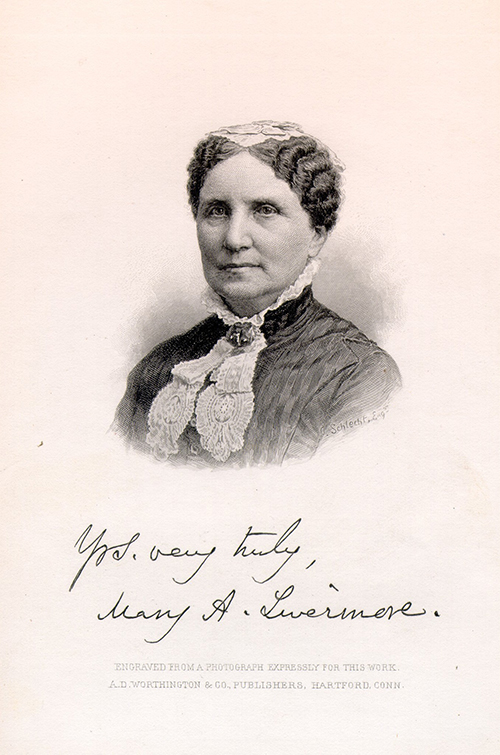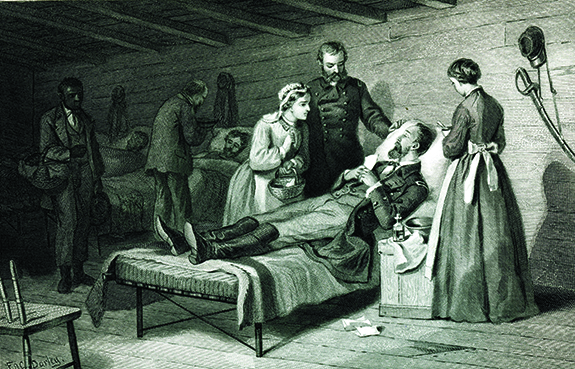My story of the war: a woman’s narrative of four years personal experience as nurse in the Union Army…Hartford, Conn.: A. D. Worthington and Company, 1888.
The story of my life: or, The sunshine and shadow of seventy years… Hartford, Conn.: A. D. Worthington and Company, 1898.
 Mary Ashton Rice Livermore, a native of Boston, Massachusetts, is one of the most well-known female figures in the Union relief movement. Before the Civil War broke out, Mary had already devoted her life to social, humanitarian and charitable causes. In her early twenties, she worked as a family tutor on a large rural Virginia plantation. In this position, she came face to face with the injustices of slavery and became a staunch abolitionist. During these pre-war years, Mary also became known for her involvement in the temperance movement, which especially thrived after her marriage to fellow temperance supporter and Universalist minister, Daniel Parker Livermore, in 1845. Mrs. Livermore organized a juvenile temperance group, the Cold Water Army, for whom she wrote short stories and read them aloud (Holland 37-38). In 1857, the Livermores and their three daughters moved from Massachusetts to Chicago, where Mary assisted her husband in editing the Northwest Universalist paper, The New Covenant. There, she also helped found two charities, the Home for Aged Women and the Hospital for Women and Children (American Reformers).
Mary Ashton Rice Livermore, a native of Boston, Massachusetts, is one of the most well-known female figures in the Union relief movement. Before the Civil War broke out, Mary had already devoted her life to social, humanitarian and charitable causes. In her early twenties, she worked as a family tutor on a large rural Virginia plantation. In this position, she came face to face with the injustices of slavery and became a staunch abolitionist. During these pre-war years, Mary also became known for her involvement in the temperance movement, which especially thrived after her marriage to fellow temperance supporter and Universalist minister, Daniel Parker Livermore, in 1845. Mrs. Livermore organized a juvenile temperance group, the Cold Water Army, for whom she wrote short stories and read them aloud (Holland 37-38). In 1857, the Livermores and their three daughters moved from Massachusetts to Chicago, where Mary assisted her husband in editing the Northwest Universalist paper, The New Covenant. There, she also helped found two charities, the Home for Aged Women and the Hospital for Women and Children (American Reformers).
When the war began, many relief organizations quickly emerged in the North, and in 1861 the United States Sanitary Commission was formed to coordinate these efforts. Mary Livermore, convinced of the need for female participation in war relief, and with the support of her husband, resigned many of her former obligations and became a leader in the Northwest Sanitary Commission, a division of the U.S. Sanitary Commission (American Reformers; Heidler & Heidler 3: 1201). In December 1862, Livermore and her friend, Jane C. Hoge, were appointed co-directors of the Chicago office. As a leader in the Commission, Livermore set up local Soldier’s Aid Societies in her vicinity, raised funds and medical supplies for the soldiers, lobbied for the relief effort, wrote Commission reports, and inspected hospitals. She personally delivered and coordinated the delivery of supplies to the battle fronts. During these many visits, she acted as an attentive nurse, and transported discharged, wounded soldiers to their homes (Holland 39). In 1863, Livermore and Hoge organized the Great Northwestern Sanitary Commission Fair, for which Mary convinced President Lincoln to donate the Emancipation Proclamation document. The fair raised nearly $100,000 for the soldiers, and it became the model for similar fund raisers in the North (Heidler & Heidler 3: 1202).
 As part of her war relief work, Mary Livermore had many opportunities to speak, during which she rallied women together and encouraged them to volunteer. After the war, she applied her speaking ability to the fights for temperance and women’s suffrage, often incorporating her Civil War experiences in these orations. In 1887, she first published a detailed account of her Sanitary Commission days in My story of the war. Not only did Livermore tell her own story in this volume, but she also included details regarding the work of other Northern nurses and women volunteers (Heidler & Heidler 3: 1201-1202). This work is a great and important primary resource on the role of women in the Union relief effort. Later in life, she published another autobiography, The story of my life, which includes additional anecdotes from her Civil War experiences (Freemon 86).
As part of her war relief work, Mary Livermore had many opportunities to speak, during which she rallied women together and encouraged them to volunteer. After the war, she applied her speaking ability to the fights for temperance and women’s suffrage, often incorporating her Civil War experiences in these orations. In 1887, she first published a detailed account of her Sanitary Commission days in My story of the war. Not only did Livermore tell her own story in this volume, but she also included details regarding the work of other Northern nurses and women volunteers (Heidler & Heidler 3: 1201-1202). This work is a great and important primary resource on the role of women in the Union relief effort. Later in life, she published another autobiography, The story of my life, which includes additional anecdotes from her Civil War experiences (Freemon 86).
Images: [From] Livermore, Mary A. My Story of the War. Hartford, CT: A. D. Worthington and Co., 1888 [c1887], Reynolds-Finley Historical Library, Arnold G. Diethelm American Civil War Medicine Collection.”
